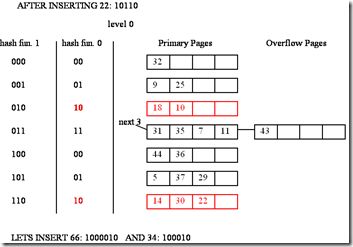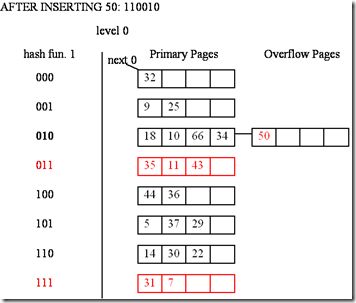Hashing
Hash函数的性质:
一致性:具有相同关键字的值被赋给同一个桶中。
随机性:每个桶将会有相同数据的记录,而不考虑文件中关键字的真实分布。
最坏性:把所有的关键字映射到同一个桶中,使得访问时间和文件中关键字的数量成正比。
Static Hashing:
如果没有空间剩余,将会分配overflow buckets, 用链表把它们连接起来。(长的链表降低了性能)
Deficiency:
一:如果初始桶的数量很少,随着文件的增长,性能将会因为太多的overflow buckets下降。
二:如果分配期望增长的空间,那么大量的空间在开始的时候都浪费了。
三:如果数据库比较小,空间再次浪费了。
One Solution: 周期的用新的Hash函数重新组织文件。
缺点是:昂贵,打乱了正常的操作。
Better solution: 动态的改变桶的数目。
Extendible Hashing
既然桶装满了,为何不用双倍的桶来组织文件?
一:只需要分裂溢出的桶。(但是读写所有的文件是很昂贵的)
Idea:使用指向桶的指针目录,通过双倍指针目录来双倍桶。因为指针目录比文件小,所以双倍指针目录会更划算。
 其中,指针目录(Directory)的大小为4。比如要插入5,它的二进制为(0101), 因为Global Depth = 2, 所以找到(01)的指针目录,插入所指向的桶中。
其中,指针目录(Directory)的大小为4。比如要插入5,它的二进制为(0101), 因为Global Depth = 2, 所以找到(01)的指针目录,插入所指向的桶中。
如果要插入20呢?因为20为(10100), 所以要插入00的指针目录中,但Bucket A 已经满了,这个时候,分裂Bucket A, 如果需要的话,还需要双倍指针目录(Directory)。
这个时候,可以看出Bucket A 分裂了,它的Local Depth为3了。所以32(100000), 16(10000)分配到一起;而4(100),12(1100), 20(10100)分配到一起。同时双倍了Directory。可以看到,Bucket C没有满,所以Local Depth为2。但是Global Depth中的001和101指向了它。
插入9(1001)呢?(这个时候导致分裂,但是没有导致双倍Directory)
Global depth of directory p: Max # of bits needed to tell which bucket an entry belongs to.
Local depth of a bucket q: # of bits used to determine if an entry belongs to this bucket.
Each bucket has ![]() pointers to it from the directory.
pointers to it from the directory.
When does bucket split cause directory doubling?
If the bucket has only 1 pointer to it from the directory, doubling the directory; Otherwise, simply redistribute the pointers after splitting.
When to merge bucket and shrink directory during deletion?
Merge Bucket: merge with its split image when bucket becomes empty.
Shrink directory: if every directory element and its split image directory entry point to the same bucket, shrink directory by ½.
Deciency:
Directory can grow large if the distribution of hash values is skewed.
Multiple entries with same hash value cause problems!
Linear Hashing
1:Handle long overflow chains.
2:Handle duplicates.
3: Idea: use a family of hash functions h0, h1, h2, ... hi+1 doubles the range of hi (similar to directory doubling) .
4: Splitting proceeds in “round”. (Round ends when all initial buckets are split. ).
5: Current round number is Level, and current function is hLevel。
address(level,key) = hash(key) mod N * (2level)
当插入43 (101011)时, 导致overflow Bucket, 因为指针没有指向它,所以不分裂。但是此时Next指针向后移动而且指针指向的桶分裂。
在Next指针前面的hash用H(level+1). 后面的用H(level).
通过指针的移动来分裂桶。
(All Above come from PPT of Ji Liping, HIT Shenzhen Graduate School)








